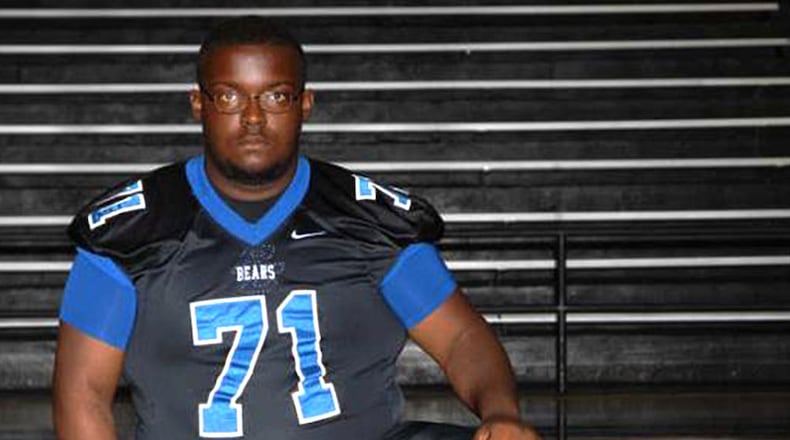They gathered around a flagpole. Then, with another school day beginning, Burke County High School said farewell to a life that had just ended.
He was 17. He was a junior. He died Monday.
He was Rod Williams, an offensive lineman for the Bears, Burke County High School’s football team in Waynesboro, just south of Augusta. He collapsed about two weeks ago during a team practice.
Rod became the fifth high school football player nationwide to die during a game or practice this season — the first in Georgia.
His death left left stunned friends standing at a flagpole outside the school Tuesday morning, looking toward the sky. Rod had talked about heaven.
One of those at the flagpole was the Rev. Clary Dishmon Jr., the football team’s chaplain. “I talked to a girl (during the vigil),” he said. “She told me she felt like an outcast at the school until Rod welcomed her.”
Related: Read and sign the online guestbook for Rod Williams. Funeral will be 1 p.m. Saturday Oct. 10, 2015 at Burke County High School.
That was Rod’s approach to life. “From elementary school on to high school, he tried to bring people together,” Dishmon said. “That’s the kind of person he was.”
He was practicing with his teammates Sept. 22 when his heart stopped. Rod, 5-foot-11 and 300 pounds, collapsed. A trainer at the practice gave him CPR until an ambulance arrived. School officials said the trainer had a defibrillator, a machine that provides an electrical shock to stimulate heartbeats, as required by law, but it was not known whether it was used.
The ambulance took Rod to Burke Medical Center, 150 miles southeast of Atlanta. Physicians there stabilized the youth and sent him to Children's Hospital of Georgia in Augusta. The cause of his death had not been determined.
On Wednesday evening, mourners again gathered at the school — this time on the football field — for a prayer vigil.
“Our hearts go out to the family, friends and teachers of our student,” said school district spokeswoman Amy Nunnally. “Our close-knit community will get through this by supporting one another.”
He became the latest casualty in a year that has claimed the lives of other young football players: Kenny Bui, 17, of Seattle; Evan Murray, 17, of New Jersey; Tyrell Cameron, 16 of Louisiana; and Ben Hamm, 16, of Oklahoma.
The Georgia High School Association is keenly aware of such tragedies. The organization, based in Thomaston, promotes all aspects of Georgia education, including athletics. It keeps track of football programs at more than 400 public and private schools. Last year, the latest for which numbers are available, nearly 34,000 Georgia students played football.
The association has guidelines to protect players, said Tommy Whittle, the organization’s associate director of football. Coaches have to adhere to rules that determine how long players can practice, and for how long — especially in the summer months, when Georgia can bake under a relentless sun.
For example, practices must be held indoors if a site exceeds maximum heat and humidity levels. The organization limits full-contact practices to 45 minutes, at a maximum of three times a week, in the preseason. That limit drops to 30 minutes during the regular season.
Yet those precautions, Whittle said, may not always work.
“We definitely hope nobody passes away or has a traumatic experience,” Whittle said. “We never expect it. We take steps to ensure that it doesn’t happen. But … sometimes it does.”
National statistics bear him out. An average of five high school football players die from direct injuries every year, according to the National Center for Catastrophic Sport Injury Research. The center, based at the University of North Carolina-Chapel Hill, has been tracking sports injuries since 1982.
The fatality rate has held steady since the early 1990s, when better sports equipment and improved medical treatment made football safer for young athletes, said Leah Thomas, a research associate at the center.
In Waynesboro, football’s latest fatality has left a school in shock.
“He was a great student,” said Wade Marchman, the high school’s athletic director. “All the kids loved to be around him.”
About the Author
The Latest
Featured


